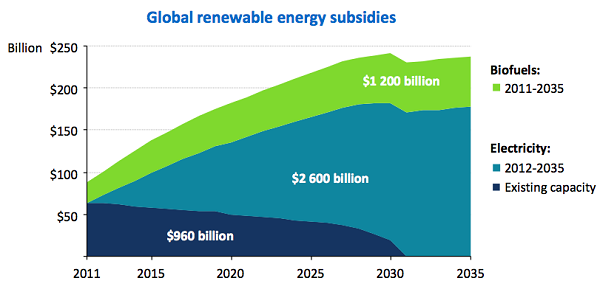Worldwide renewable energy subsidies will increase to USD 230 billion (EUR 185m) in 2030 from USD 121 billion in 2013, the International Energy Agency (IEA) says in a new report.
By comparison, global subsidies for renewable energy projects rose 15% between 2012 and 2013. Once they surge to the projected amount in 2030, they are set to decline to USD 205 billion in 2040 as support for recently-deployed capacity will end, IEA said in its Medium-Term Renewable Energy Market Report 2014.
This figure comes under the agency’s New Policies Scenario, which suggests that the European Union (EU) will be the biggest supporter of renewables till 2040.
By technology, solar photovoltaic (PV) schemes will continue to get the largest portion of subsidies until 2040. Subsidies for the onshore wind segment are forecast to reach the highest levels just before 2020 and decrease steadily after that.
Last year, five countries in the world grabbed almost 70% of all subsidies for renewables. Projects in Germany received USD 22 billion, those in the US were backed by USD 15 billion, while in Italy the support was USD 14 billion. Spain and China got USD 8 billion and USD 7 billion, respectively.
The share of renewables in total power generation globally will jump to 33% in 2040, while several years before that they will have overtaken coal as the top electricity source, the International Energy Agency (IEA) says.
By comparison, in 2013 renewables accounted for 21% of worldwide power.
Under the central scenario — the New Policies Scenario — in IEA’s World Energy Outlook 2014 (WEO-2014), renewable electricity generation, with hydropower included, nearly trebles between 2012 and 2040. China will be the one to achieve the largest jump in generation from renewables, more than that in the European Union (EU), the US and Japan together.
Renewables will be responsible for nearly half of the increase in power generation around the globe to 2040.
The WEO-2014 central scenario shows that in the next couple of years wind, solar and the other green energy technologies combined can overtake gas as the second-largest source of power generation and after 2035 they are seen surpassing coal as the number-one source. Wind power is projected to bring the largest share of growth in renewables generation, followed by hydropower and solar plants.
“Renewables are expected to go from strength to strength, and it is incredible that we can now see a point where they become the world’s number one source of electricity generation,” said IEA executive director Maria van der Hoeven.
















Comments